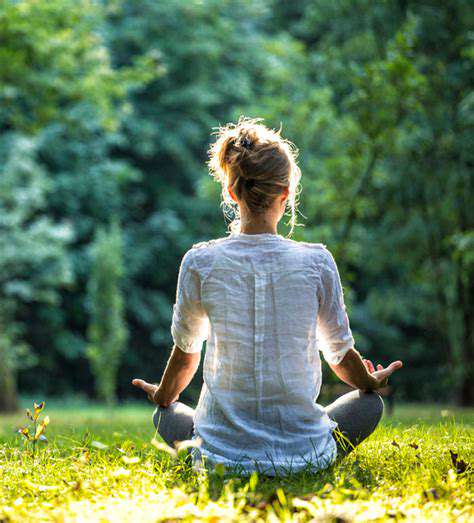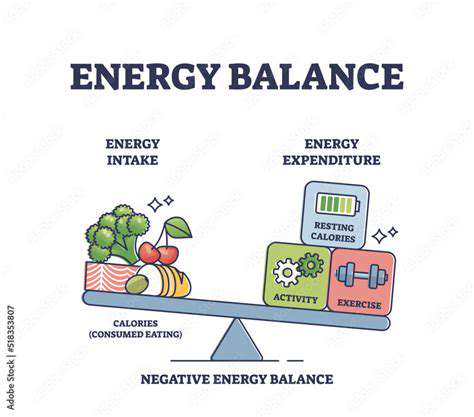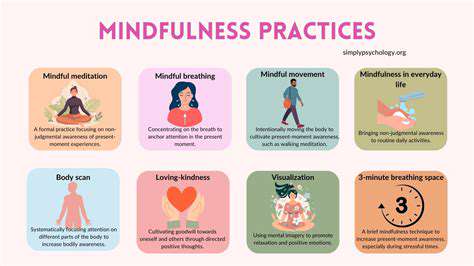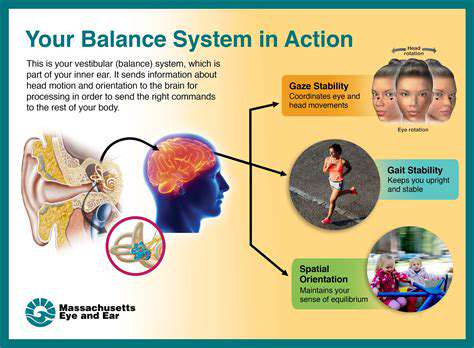Setting up an area for yoga and mindfulness
Designing Your Sanctuary: Aesthetics and Functionality
Creating a Calming Atmosphere
Your yoga space should feel like a peaceful retreat from the outside world. Gentle lighting works wonders—try warm-toned lamps or delicate string lights to set the mood. Adding living plants brings both beauty and cleaner air to your practice area. For colors, think soothing blues, earthy greens, or soft neutral tones that help quiet the mind. Stay away from bright, jarring colors or busy patterns that might pull your attention away from your practice.
The space you create should whisper relax the moment you step into it. Consider what feeling you want to cultivate—serene stillness, gentle energy, or cozy comfort. This foundation of calm will support every pose and breath you take.
Choosing the Right Flooring
What's under your feet matters more than you might think. Your flooring needs to support your joints while keeping you stable during poses. A quality yoga mat offers both cushioning and grip. If you prefer something different, a thick area rug can provide similar benefits with a softer look. Hardwood or tile can work if you like minimalism, but make sure it's not slippery—safety first!
Strategic Storage Solutions
Clutter is the enemy of calm. Keep your space tidy with smart storage options that work with your room. Floating shelves make great use of wall space without eating up floor area. Storage ottomans do double duty—extra seating that secretly holds your props. When everything has its place, your mind stays clearer for practice. You'll spend less time searching for blocks and more time flowing through poses.
Incorporating Natural Light and Ventilation
Sunlight and fresh air breathe life into your practice space. Position your mat near a window if possible, using light-filtering curtains to soften harsh rays. Good airflow keeps the energy fresh—try cracking a window or using a quiet fan. Morning sunlight can make your sun salutations feel truly magical. Just be mindful of glare if you practice at midday.
Selecting the Right Furniture
Less is usually more in a yoga space, but a few well-chosen pieces can elevate your practice. A meditation cushion or low bench gives you options for seated poses. A small side table keeps essentials like water and towels within reach. Choose pieces that blend seamlessly with your space rather than dominating it—function should meet form gracefully.
Ergonomic Considerations
Your body will thank you for thinking about ergonomics. Make sure your mat provides enough padding for your knees and spine. Place props where you can reach them without straining. An aligned body leads to a clearer mind—set up your space to support both. If something feels off during practice, don't hesitate to adjust your setup.
Personalization and Inspiration
This is your sanctuary—make it speak to your soul. Maybe it's a framed quote that motivates you, or a small altar with meaningful objects. Perhaps it's simply your favorite color in the curtains. These personal touches transform a workout space into a sacred retreat. Let the space reflect what brings you peace and joy—that energy will infuse every practice.
Essential Equipment and Supplies for Your Practice
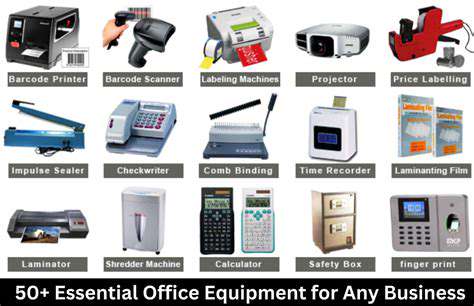
Essential Safety Gear
Safety isn't glamorous, but it's absolutely vital. Quality protective equipment is non-negotiable—it's your first line of defense against injury. Basic items like impact-resistant glasses, durable gloves, and proper shoes can prevent countless accidents. Think about your specific needs—maybe ear protection for loud environments or a respirator for dusty work.
The right gear doesn't just protect you—it lets you work with confidence and focus. Don't cut corners here; your future self will thank you when you avoid that near-miss.
Power Tools and Accessories
A well-chosen set of power tools can handle most projects with ease. Cordless drills, orbital sanders, and compact saws form a great starter kit. Invest in tools that feel good in your hands—comfort leads to better control and results. Remember that accessories often matter as much as the tools themselves; quality blades and bits make all the difference.
Keep your tools organized with a pegboard or toolbox. Nothing kills productivity like searching for the right attachment mid-project. An organized workspace is a productive workspace—take the time to set it up right.
Measuring and Marking Tools
Precision separates amateur work from professional results. A combination square does the work of three separate tools. Laser measures give instant, accurate readings without wrestling with tape. Measure twice becomes measure once when you use the right tools. For marking, try carpenter's pencils—their flat shape won't roll away like regular pencils.
Keep your measuring tools clean and protected. A bent ruler or foggy level leads to frustrating mistakes. A little care goes a long way in maintaining accuracy.
Storage and Organization Solutions
Chaos breeds mistakes and wasted time. Clear bins let you see contents at a glance. Magnetic strips keep metal tools accessible but off your workspace. Every minute spent organizing saves ten minutes searching later. Label everything—future you will appreciate the clarity.
Consider workflow when arranging your space. Keep frequently used items closest to your main work area. Less-used specialty tools can live on higher shelves or in back cabinets.
Hand Tools and Accessories
No power? No problem. A well-stocked hand tool collection handles most basic repairs. Look for ergonomic handles that reduce hand fatigue. A quality screwdriver set solves more household problems than people realize. Keep your tools clean and lightly oiled—rust never sleeps.
For small parts organization, try compartmentalized cases or clear jars. Nothing's more frustrating than losing that one special washer in a pile of nearly identical ones.
Selecting wedding music is like choosing the perfect wine pairing—it elevates every moment. Your playlist becomes the emotional throughline of your celebration, from the processional's first notes to the last dance's final chord. Whether you dream of timeless elegance, joyful energy, or quirky charm, let the music tell your unique love story.
Incorporating Nature: Bringing the Outdoors In
Choosing a Space
Location sets the tone for your practice. South-facing windows bathe the space in warm light all day. A corner near a tree outside brings shifting natural patterns indoors. Even small spaces can work—it's about how you use them. Listen to the room's energy before committing; some spaces just feel right.
Incorporating Greenery
Plants do more than look pretty—they literally breathe life into your space. Snake plants thrive on neglect while cleaning the air. A hanging pothos adds vertical interest without floor space. Choose plants that make you happy when you see them—that joy will infuse your practice. Even a single bloom in a vase can lift your spirits.
Natural Light and Ventilation
Play with light throughout the day—morning's soft glow differs from afternoon's golden hour. Sheer curtains diffuse harsh sunlight beautifully. Crack windows slightly to invite fresh air without drafts. Notice how the changing light affects your mood and energy during practice. Your body responds differently to morning coolness versus evening warmth.
Using Natural Materials
Nature's textures soothe the senses in ways plastic never can. A bamboo floor mat feels wonderful under bare feet. Stone bookends hold your inspiration books solidly. These elements ground you literally and figuratively during practice. Even small touches like a wooden candle holder make a difference.
Adding Textures and Colors
Layer natural fabrics for visual interest—linen drapes over cotton cushions. Earthy tones create calm, while leaf-green accents add vitality. Texture variety keeps the space interesting without being distracting. Run your hands over surfaces during meditation—the tactile experience enhances mindfulness.
Designing for Sound and Harmony
Nature's soundtrack needs no playlist. A small tabletop fountain masks street noise beautifully. Wind chimes outside the window add unpredictable melody. These subtle sounds help drown out mental chatter during practice. Even the hum of a ceiling fan can become a focusing tool.
Creating a Sense of Tranquility
Your space should feel like a deep breath made physical. Keep surfaces mostly clear—one meaningful object beats ten distractions. Every item should earn its place by bringing you peace or inspiration. When in doubt, less is more. The space should hold you, not compete for your attention.
Maintaining Your Sanctuary: Creating a Routine
Establishing Your Sacred Space
Your dedicated area becomes sacred through regular use and care. This isn't just about cleaning—it's about honoring the space's purpose. Notice how dust accumulates in certain spots—that's where energy stagnates too. A quick daily tidy keeps the space inviting for impromptu practice sessions.
Refresh the energy occasionally with open windows or a singing bowl's vibration. Rotate decor seasonally to keep the space feeling alive. Your care for the space reflects your care for your practice.
Designing for Comfort and Functionality
Your setup should evolve as your practice does. Maybe you need more prop storage now, or better lighting for evening sessions. Listen to what your practice is telling you it needs—then adjust accordingly. That awkward reach for blocks? Time to rearrange. Sore knees? Maybe add extra padding.
Clean your mat regularly—it's where you spend most of your practice time. A simple spray of water and essential oils keeps it fresh. Store it properly to prevent curling and wear.
Incorporating Mindfulness into Your Routine
Your space can prompt mindfulness before you even begin. The act of lighting a candle becomes a ritual. Folding your blanket neatly prepares your mind. These small actions build bridges between daily life and practice time. Even putting your phone on silent is a mindful choice.
Leave a journal nearby to capture insights post-practice. The physical act of writing helps integrate the experience. Over time, you'll see patterns and growth.
Scheduling Your Practice
Consistency matters more than duration. Ten mindful minutes daily beats one distracted hour weekly. Anchor your practice to an existing habit—after morning coffee or before evening showers. The association strengthens both routines.
Be realistic—if you're not a morning person, don't force dawn practices. Honor your natural rhythms for sustainable consistency.
Maintaining Your Space
Treat maintenance as part of the practice itself. Dusting becomes moving meditation. Rearranging props is a body-awareness exercise. When care feels like practice rather than chore, it stops being optional. Your space reflects your commitment—keep that reflection clear.
Adapting Your Routine
Life changes, and so should your practice. A new injury might mean more restorative poses. Stressful periods might need longer savasana. Your mat should be a place of compassion, not rigid expectations. Some days five minutes is enough—honor that.
Seasonal changes invite natural shifts too—lighter practices in summer's heat, more introspection in winter. Let your space evolve with you.
